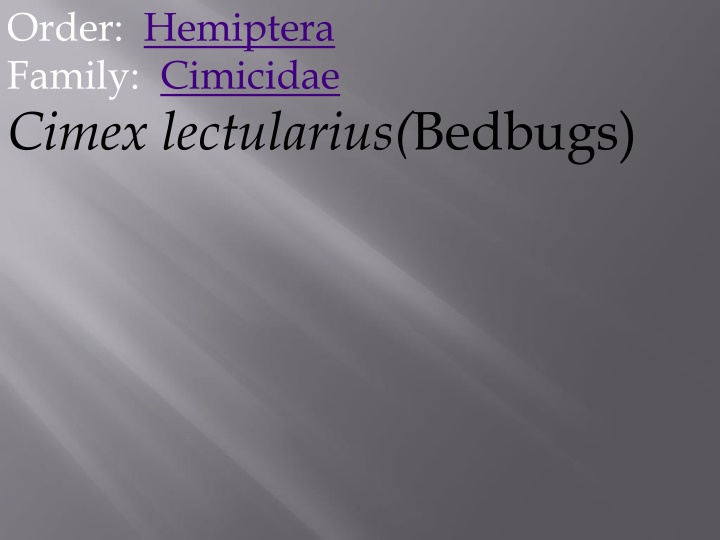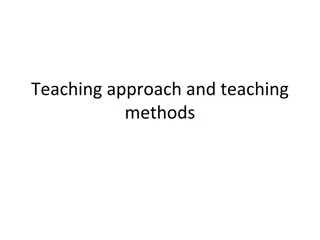
Bedbugs: Characteristics and Life Cycle
Learn about bedbugs, members of the Cimicidae family in the Hemiptera order, including their physical traits, behavior, and life cycle. Explore detailed information on bedbug anatomy, feeding habits, and reproduction. Discover how to identify bedbug bites and manage infestations effectively to protect your home and health.
Download Presentation

Please find below an Image/Link to download the presentation.
The content on the website is provided AS IS for your information and personal use only. It may not be sold, licensed, or shared on other websites without obtaining consent from the author. If you encounter any issues during the download, it is possible that the publisher has removed the file from their server.
You are allowed to download the files provided on this website for personal or commercial use, subject to the condition that they are used lawfully. All files are the property of their respective owners.
The content on the website is provided AS IS for your information and personal use only. It may not be sold, licensed, or shared on other websites without obtaining consent from the author.
E N D
Presentation Transcript
Order: Hemiptera Family: Cimicidae Cimex lectularius(Bedbugs)
1. Adult of bedbugs are oval, wingless insects which are flattened dorsoventrally. 2. They are about 5 7mm long and when unfed pale yellow or brown, but after a full blood- meal they become a characteristically darker mahogany brown. http://upload.wikimedia.org/wikipedia/commons/thumb/8/87/Bed_bug%2C_Cimex_lectularius.jpg/250px-Bed_bug%2C_Cimex_lectularius.jpg
3.The head is short and broad and has a pair of prominent compound eyes, in front of which is a pair of four- segmented antennae.
4.The proboscis is slender, and is normally held closely appressed under the head and prothorax, but when the bug takes a blood- meal it is swung forward and downwards. https://encrypted-tbn3.gstatic.com/images?q=tbn:ANd9GcQOt7h0e6kt4qp09VBabHeYCtQH8oAOC5mwftXEwKMnxcK3AFebm26Pkypf
5.The prothorax is much larger than the meso- and metathorax and has distinct wing-like expansions.Two rudimentary and non-functional more or less oval wing pads, termed hemelytra, overlie the meso- and metathorax. 6.The three pairs of legs are slender but well developed. http://upload.wikimedia.org/wikipedia/commons/thumb/8/87/Bed_bug%2C_Cimex_lectularius.jpg/250px-Bed_bug%2C_Cimex_lectularius.jpg
7. In adult males the tip of the abdomen is slightly more pointed than in females, while closer examination shows a small well-developed curved penis .In females there is a small incision ventrally on the left side of the apparent fourth abdominal segment .This opens into a special pouch called the organ of Berlese or organ of Ribaga, which collects and stores sperm.
Nymph of bedbug Bedbug bites on human
Females lay about 24 eggs a day. Eggs are about 1mm ,long, pearly white or yellowish white, covered with a very fine and delicate mosaic pattern. The life cycle is hemimetabolous and there are five nymphal instars each lasting 3 10 days. The life cycle, from egg to adult can be just 3 4 weeks if temperatures are high and food plentiful, but is more usually 6 10 week
Bedbug infestations can be detected by the presence of live bugs, cast-off nymphal skins, and hatched and unhatched eggs. small dark brown or black marks may be visible on bed sheets, walls and wallpaper: these are the bedbug s excreta and consist mainly of excess blood ingested during feeding. Feed on exposed skin, face, neck, hands or arms Bite characteristics: Small, hard, swollen white welt may develop at the site of the bite Rash may occur May cause itching that lasts several days
Rhodnius prolixus and Triatoma sp. They are commonly called assassin bugs or kissing bugs. 1-The size vary from 5 to 45mm in length, but most are 20 30mm long. brown-black colour, 2- easily recognized by their long snout-like head having a pair of prominent dark-coloured eyes. 3-Antennae long and thin, four-segmented.
4- Piercing sucking mouth part consist of proboscis, sometimes called the rostrum, which is relatively thin and straight, lies closely appressed to the ventral surface of the head, when it take a blood-meal the proboscis is swung forward and downwards.
5- The first segment of thorax is called pronotum which is very conspicuous triangular shape, meso-and metathorax are hidden dorsally by the folded fore- wings. 6- The fore wings called hemelytra, the basal part of each hemelytron is thickened and relatively hard, whereas the more distal part is membranous, Hind- wings are entirely membranous. 7- Legs are Long and slender end in paired small claws. 8- The abdomen is 11-segmented more or less oval in shape but is mostly hidden by the wings, except for the lateral margins, which are bent upwards slightly and are visible dorsally.
Eggs are about 1.52.5mm long, oval in shape Typically females lay 1 2 eggs a day. There are five nymphal instars life cycle from egg to adult can take 3 10 months.
1-Biting is usually relatively painless and most people are not woken up when it occurs. In some cases severe itching and other skin problems occur afterwards. Large populations of triatomine bugs can cause chronic anaemia through loss of blood . 2- chagas disease : caused by the flagellate protozoan Trypanosoma cruzi.and trasmitted by bite of the bug.
A small sore often develops at the point where the parasite enters the body. If this site is around the eye a marked swelling of the eyelid may develop, known as Roma a s sign.




